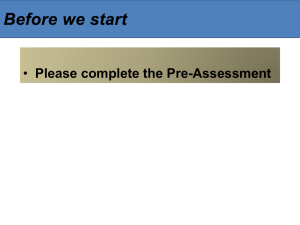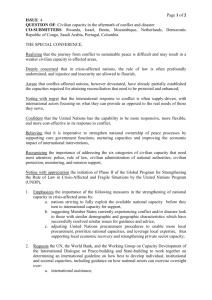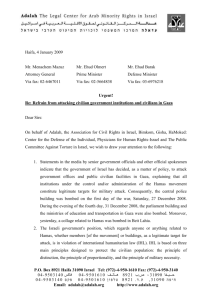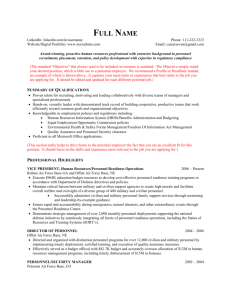Lecture 5 Methods 07 slides
advertisement
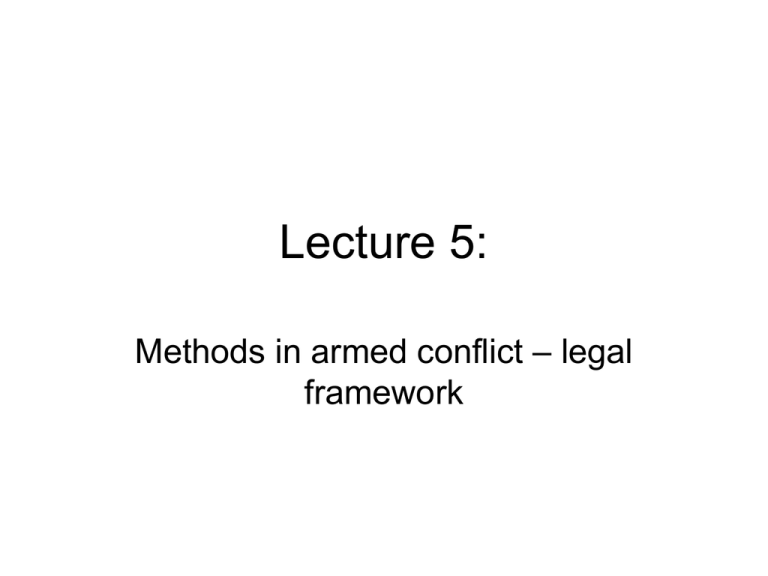
Lecture 5: Methods in armed conflict – legal framework Main topics: – Distinction between combatants and civilians – Combatant status – Definition of civilians – Distinction between combatants and soldiers hors de combat – Legitimate targets – Perfidy and ruses of war – Reprisals Distinction between combatants and civilians: Humanity Proportionality or Unnecessary injury Distinction Military necessity Civilians and combatants • Civilians – Persons who are not combatants • Combatants – Lawful combatants – Unlawful combatants – Combatants hors de combat – Non-combatants (Members of the armes forces who are not combatants) Primary and secondary status • Primary status • Secondary status • Combatant: • Legitimate target • (Immunity for acts of war) • Hors de combat • POW • Civilian: • Protected person • (Not immunity for acts of war) • Unlawful combatant • Detainee (not POW) Definition of combatant (1) • Members of the armed forces of States Art.4 A (1), GC III Art. 43 (1) and (2), AP I • Specific exceptions to this rule: – Medical and religious personnel Art. 43 (2) AP I and Art. 33 GC III Definition of combatant (2) • Members of resistance movements or guerrilla groups (irregular forces) belonging to a State party to the conflict – 1949: Art. 4 A (2) (GC III) : Command structure, visible sign/uniform, visible arms, adherence to IHL – 1977: Art. 43 (AP I): Command structure, adherence to IHL. But (Art. 44 (3) AP I): must carry arms openly during military attacks and preparation (when visible) • Art.44 (3):3. In order to promote the protection of the civilian population from the effects of hostilities, combatants are obliged to distinguish themselves from the civilian population while they are engaged in an attack or in a military operation preparatory to an attack. Recognizing, however, that there are situations in armed conflicts where, owing to the nature of the hostilities an armed combatant cannot so distinguish himself, he shall retain his status as a combatant, provided that, in such situations, he carries his arms openly: (a) during each military engagement, and (b) during such time as he is visible to the adversary while he is engaged in a military deployment preceding the launching of an attack in which he is to participate. • Art.44 (4) A combatant who falls into the power of an adverse Party while failing to meet the requirements set forth in the second sentence of paragraph 3 shall forfeit his right to be a prisoner of war, but he shall, nevertheless, be given protections equivalent in all respects to those accorded to prisoners of war by the Third Convention and by this Protocol. This protection includes protections equivalent to those accorded to prisoners of war by the Third Convention in the case where such a person is tried and punished for any offences he has committed. (5) Any combatant who falls into the power of an adverse Party while not engaged in an attack or in a military operation preparatory to an attack shall not forfeit his rights to be a combatant and a prisoner of war by virtue of his prior activities. Unlawful combatants • Irregular forces (or saboteurs) outside the scope of POW protection under either – 1) Art. 4 A (2) GC III, or – 2) Art. 44 (3) AP • Civilians who participate in hostilities (except levée en masse) • Spies • Mercenaries Determination of Status • Difficult to determine status of detained persons – therefore: • All captured persons who have taken part in hostilities must be treated as POWs until status is determined, if necessary by a competent tribunal: Art.45 (1), AP I and Art. 5, GC III Combatant status in noninternational armed conflicts • Law on NIAC (Non-International Armed Conflict) do not deal with combatant status • Members of dissident armed groups/forces remain liable to prosecution under domestic law • Any person detained in NIACs must be treated humanely: Common Art.3, GC and Art.4, AP II. Distinction • WWI: civilian casualties 5% • WWII: civilian casualties 50% • Caused by indiscriminate air warfare by both sides • (Violations of the principle of distinction was excluded from the charges brought at the Nuremberg and Tokyo trials) Article 48 AP I • Art 48. Basic rule In order to ensure respect for and protection of the civilian population and civilian objects, the Parties to the conflict shall at all times distinguish between the civilian population and combatants and between civilian objects and military objectives and accordingly shall direct their operations only against military objectives. • Civilian objects • Military objectives • Civilians can never be objectives Article 49, AP I • 1. ”Attacks” means acts of violence against the adversary, whether in offence or defense. Article 50 AP I • Art 50. Definition of civilians and civilian population 1. A civilian is any person who does not belong to one of the categories of persons referred to in Article 4 (A) (1), (2), (3) and (6) of the Third Convention and in Article 43 of this Protocol. In case of doubt whether a person is a civilian, that person shall be considered to be a civilian. • Persons referred to in Article 4 A, (1), (2), (3) and (6) of GC III, and art. 43 AP I are not civilians: – Members of the armed forces – Members of militias etc. – Members of armed forces of a government not recognized by the detaining power – Civilians taking up arms against invasion • Conversely: persons referred to in article 4 A, (4) and (5) and art.43 (2) AP I are to be treated as civilians – Medical personnel and chaplains and other persons accompanying the armed forces or members of technical crews Article 50 (continued) 2. The civilian population comprises all persons who are civilians. 3. The presence within the civilian population of individuals who do not come within the definition of civilians does not deprive the population of its civilian character. Article 51, AP I • Art 51. - Protection of the civilian population 1. The civilian population and individual civilians shall enjoy general protection against dangers arising from military operations. To give effect to this protection, the following rules, which are additional to other applicable rules of international law, shall be observed in all circumstances. Protection against being targeted • Art.51 (2) The civilian population as such, as well as individual civilians, shall not be the object of attack. Acts or threats of violence the primary purpose of which is to spread terror among the civilian population are prohibited. Direct Participation in Hostilities • Art.51 (3) Civilians shall enjoy the protection afforded by this section, unless and for such time as they take a direct part in hostilities. • Common article 3: Persons taking no active part in the hostilities…. Protection against indiscriminate attcks • Art.51 (4) Indiscriminate attacks are prohibited. Indiscriminate attacks are: (a) those which are not directed at a specific military objective; (b) those which employ a method or means of combat which cannot be directed at a specific military objective; or (c) those which employ a method or means of combat the effects of which cannot be limited as required by this Protocol; and consequently, in each such case, are of a nature to strike military objectives and civilians or civilian objects without distinction. • Article 51 (5) Among others, the following types of attacks are to be considered as indiscriminate: • (a) an attack by bombardment by any methods or means which treats as a single military objective a number of clearly separated and distinct military objectives located in a city, town, village or other area containing a similar concentration of civilians or civilian objects; Protection against excessive loss of civilian lives – (proportionality) • Art.51 (5) • (b): an attack which may be expected to cause incidental loss of civilian life, injury to civilians, damage to civilian objects, or a combination thereof, which would be excessive in relation to the concrete and direct military advantage anticipated. Protection of civilans against: • being targeted • indiscriminate attacks • To fire blindly without clear idea of the target • To release random bombs • To release bombs when visibility is bad (night, high altutudes, weather, etc.) • To release bombs over areas with both military and civilian installations • excessive loss of civilian lives Distinction between combatants and soldiers hors de combat: HUMANITY Proportionality or Unnecessary injury Distinction Military necessity Common Art. 3, GC (1949) • (1) Persons taking no active part in the hostilities, including members of armed forces who have laid down their arms and those placed ' hors de combat ' by sickness, wounds, detention, or any other cause, shall in all circumstances be treated humanely, without any adverse distinction founded on race, colour, religion or faith, sex, birth or wealth, or any other similar criteria. Article 41, AP I • 1. A person who is recognized or who, in the circumstances, should be recognized to be ' hors de combat ' shall not be made the object of attack. 2. A person is ' hors de combat ' if: (a) he is in the power of an adverse Party; (b) he clearly expresses an intention to surrender; or (c) he has been rendered unconscious or is otherwise incapacitated by wounds or sickness, and therefore is incapable of defending himself; provided that in any of these cases he abstains from any hostile act and does not attempt to escape. Article 40, AP I Article 40 Quarter • It is prohibited to order that there shall be no survivors, to threaten an adversary therewith or to conduct hostilities on this basis. Legitimate military targets • Is everything which is not specifically prohibited a legitimate target? • Rules on legitimate military objectives: • Military objective was not defined in the Geneva Conventions • AP I, Chapter III – Civilian Objects (Negative definition: everything that is not a a military objective is a civilian object.) AP I, Article 52 • 1. Civilian objects shall not be the object of attack or of reprisals. Civilian objects are all objects which are not military objectives as defined in paragraph 2. • 2. Attacks shall be limited strictly to military objectives. In so far as objects are concerned, military objectives are limited to those objects which by their nature, location, purpose or use make an effective contribution to military action and whose total or partial destruction, capture or neutralization, in the circumstances ruling at the time, offers a definite military advantage. AP I, Article 52 (cont.) • military objectives are limited to those objects which by their nature, location, purpose or use make an effective contribution to military action AP I, Article 52 (cont.) • military objectives are limited to those objects which by their nature, location, purpose or use make an effective contribution to military action • Military fortifications, military bases, military training facilities, military units of all kinds, weapons, weapons launching systems, military vehicles and aircrafts, military airfields, warships, military storages, weapons and ammunition factories, ministries of defence, military headquarters…. AP I, Article 52 (cont.) • military objectives are limited to those objects which by their nature, location, purpose or use make an effective contribution to military action AP I, Article 52 (cont.) • military objectives are limited to those objects which by their nature, location, purpose or use make an effective contribution to military action AP I, Article 52 (3) • 3. In case of doubt whether an object which is normally dedicated to civilian purposes, such as a place of worship, a house or other dwelling or a school, is being used to make an effective contribution to military action, it shall be presumed not to be so used. Other rules on limitations to targeting • Art.53: Cultural objects and places of worship • Art.54: Objects indispensable to the survival of the civilian population (food, water) • Art.55: Protection of the natural environment • Art. 56: protection of works and installations containing dangerous forces–such as dams, dykes and nuclear electrical generating stations Precautions in attack • Art.57 (2) With respect to attacks, the following precautions shall be taken: (a) those who plan or decide upon an attack shall: • (i) do everything feasible to verify that the objectives to be attacked are neither civilians nor civilian objects and are not subject to special protection but are military objectives within the meaning of paragraph 2 of Article 52 and that it is not prohibited by the provisions of this Protocol to attack them; • (b) an attack shall be cancelled or suspended if it becomes apparent that the objective is not a military one or is subject to special protection or that the attack may be expected to cause incidental loss of civilian life, injury to civilians, damage to civilian objects, or a combination thereof, which would be excessive in relation to the concrete and direct military advantage anticipated; (c) effective advance warning shall be given of attacks which may affect the civilian population, unless circumstances do not permit. • 3. When a choice is possible between several military objectives for obtaining a similar military advantage, the objective to be selected shall be that the attack on which may be expected to cause the least danger to civilian lives and to civilian objects. Perfidy and ruses of war • Perfidy is prohibited • Ruses of war is not prohibited • Both involve deception: How to tell them apart? Perfidy: Article 37, AP I • 1. It is prohibited to kill, injure or capture an adversary by resort to perfidy. Acts inviting the confidence of an adversary to lead him to believe that he is entitled to, or is obliged to accord, protection under the rules of international law applicable in armed conflict, with intent to betray that confidence, shall constitute perfidy. Three elements of perfidy: 1. The existence of a norm of international law applicable in armed conflict, which would give protection under certain circumstances 2. Inducing the enemy to trust that such circumstances has arisen 3. An intent to break that trust Article 37, AP I (cont.) • The following acts are examples of perfidy: (a) the feigning of an intent to negotiate under a flag of truce or of a surrender; (b) the feigning of an incapacitation by wounds or sickness; (c) the feigning of civilian, non-combatant status; and (d) the feigning of protected status by the use of signs, emblems or uniforms of the United Nations or of neutral or other States not Parties to the conflict. Ruses of war, Art. 37 (2), AP I • 2. Ruses of war are not prohibited. Such ruses are acts which are intended to mislead an adversary or to induce him to act recklessly but which infringe no rule of international law applicable in armed conflict and which are not perfidious because they do not invite the confidence of an adversary with respect to protection under that law. The following are examples of such ruses: the use of camouflage, decoys, mock operations and misinformation. Reprisals • Reprisals are acts that would normally be illegal – and which have the purpose of enforcing compliance with international law. • Reaction to illegal acts committed by the enemy, with the purpose of making such acts stop – NOT REVENGE Exempt from reprisals (examples:) • Article 46, GC I: Reprisals against the wounded, sick, personnel, buildings or equipment protected by the Convention are prohibited. • Art.51 (6), AP I: Attacks against the civilian population or civilians by way of reprisals are prohibited. • Articles 51 to 56 of AP I


